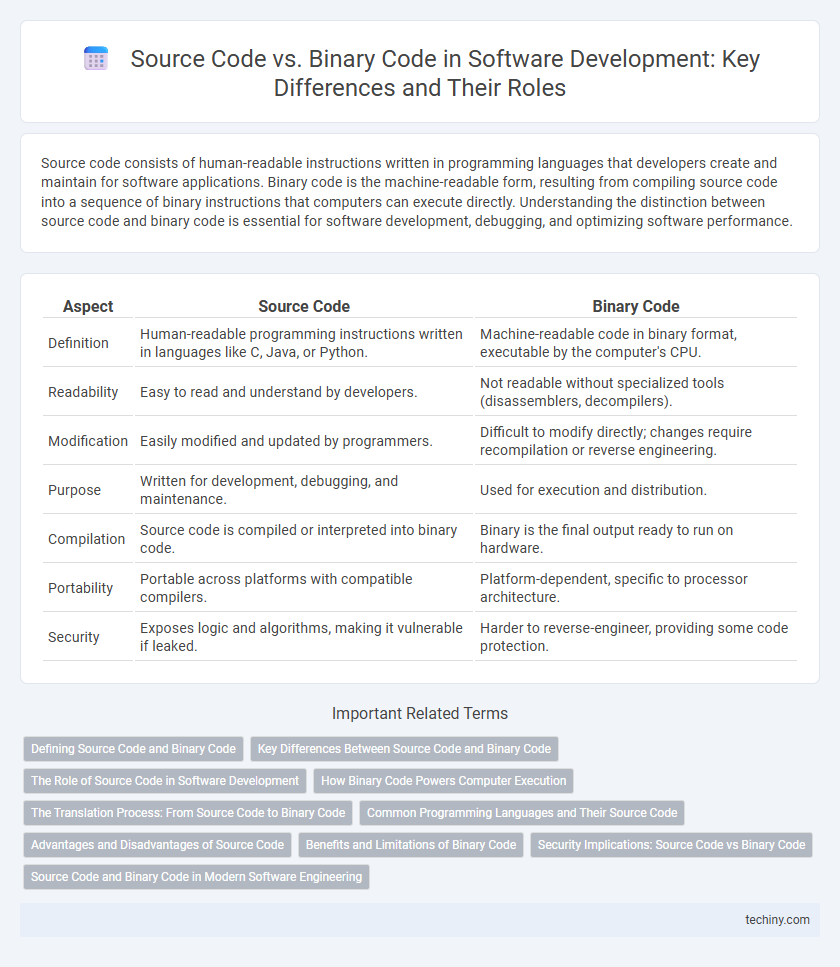Source code consists of human-readable instructions written in programming languages that developers create and maintain for software applications. Binary code is the machine-readable form, resulting from compiling source code into a sequence of binary instructions that computers can execute directly. Understanding the distinction between source code and binary code is essential for software development, debugging, and optimizing software performance.
Table of Comparison
| Aspect | Source Code | Binary Code |
|---|---|---|
| Definition | Human-readable programming instructions written in languages like C, Java, or Python. | Machine-readable code in binary format, executable by the computer's CPU. |
| Readability | Easy to read and understand by developers. | Not readable without specialized tools (disassemblers, decompilers). |
| Modification | Easily modified and updated by programmers. | Difficult to modify directly; changes require recompilation or reverse engineering. |
| Purpose | Written for development, debugging, and maintenance. | Used for execution and distribution. |
| Compilation | Source code is compiled or interpreted into binary code. | Binary is the final output ready to run on hardware. |
| Portability | Portable across platforms with compatible compilers. | Platform-dependent, specific to processor architecture. |
| Security | Exposes logic and algorithms, making it vulnerable if leaked. | Harder to reverse-engineer, providing some code protection. |
Defining Source Code and Binary Code
Source code is the human-readable set of instructions written in programming languages such as Python, Java, or C++, which developers create and edit to build software applications. Binary code is the machine-readable version of source code, consisting of binary digits (0s and 1s) produced by compilers or assemblers to execute programs directly on hardware. Understanding the transformation from source code to binary code is essential for software compilation, debugging, and performance optimization.
Key Differences Between Source Code and Binary Code
Source code consists of human-readable programming instructions written in languages like Python, Java, or C++, enabling developers to create and modify software easily. Binary code represents the compiled, machine-readable instructions composed of binary digits (0s and 1s) executed directly by the computer's CPU. The key differences lie in source code's readability and editability versus binary code's execution efficiency and hardware-specific format.
The Role of Source Code in Software Development
Source code serves as the foundational human-readable instructions written in programming languages that guide software development. It enables developers to design, test, and maintain applications efficiently by providing a clear and modifiable blueprint. Without source code, converting ideas into executable binary code and ensuring software functionality and updates would be impractical.
How Binary Code Powers Computer Execution
Binary code, composed of a series of 0s and 1s, directly controls the hardware by signaling electrical states within a computer's processor. Unlike source code, which is written in human-readable programming languages, binary code is the machine-level representation that executes instructions at the fundamental level. This code enables the CPU to perform computations, manage memory, and communicate with peripherals, effectively powering all software operations on a device.
The Translation Process: From Source Code to Binary Code
The translation process from source code to binary code involves compiling high-level programming languages like C++ or Java into machine-readable instructions executed by a computer's CPU. Compilers perform lexical analysis, syntax parsing, semantic analysis, optimization, and code generation to produce efficient binary executables or object files. This transformation allows human-readable code to be converted into low-level binary code, enabling software applications to run directly on hardware platforms.
Common Programming Languages and Their Source Code
Common programming languages such as Python, Java, and C++ generate source code that is human-readable and written using specific syntax and semantics tailored to each language. Source code undergoes compilation or interpretation to produce binary code, consisting of machine-readable instructions directly executed by the CPU. Understanding the distinction between source code in languages like Java or C# and the resulting binary code is crucial for debugging, optimization, and software deployment processes.
Advantages and Disadvantages of Source Code
Source code offers ease of understanding, modification, and debugging, enabling developers to optimize and customize software efficiently. Its readability facilitates collaborative development and version control, essential for maintaining complex projects. However, source code is vulnerable to unauthorized access and intellectual property theft, requiring robust security measures to protect proprietary algorithms and designs.
Benefits and Limitations of Binary Code
Binary code offers significant benefits in software development, including faster execution speed and direct interaction with hardware, which improves overall system performance. However, its limitations include difficulty in debugging and lack of readability, making maintenance and updates challenging without the original source code. Despite these constraints, binary code remains essential for efficient software deployment and execution in various computing environments.
Security Implications: Source Code vs Binary Code
Source code exposes human-readable instructions, making it vulnerable to unauthorized access and potential code theft during development or distribution. Binary code, being compiled and machine-readable, offers inherent protection against direct inspection but can still be reverse-engineered through disassembly and decompilation techniques. Effective security measures include code obfuscation, strict access controls on source repositories, and regular vulnerability assessments on both source and binary artifacts.
Source Code and Binary Code in Modern Software Engineering
Source code in modern software engineering serves as the human-readable set of instructions written in programming languages such as Python, Java, or C++, enabling developers to design, test, and maintain complex applications. Binary code is the machine-readable output generated by compilers or assemblers, translating source code into executable instructions understood by computer processors. Efficient software development relies on the clear distinction and optimization between source code for maintainability and binary code for performance and deployment.
Source Code vs Binary Code Infographic

 techiny.com
techiny.com